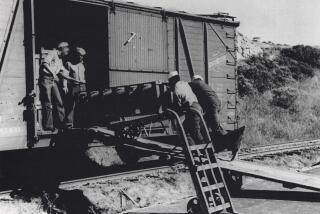Another battleship tragedy--similar to the Iowa--occurred 65 years ago, off San Clemente Island.
- Share via
The explosion tore through the No. 2 gun turret during a firing exercise on the big American battleship, killing more than 40 sailors and triggering an inquiry into how such an accident could occur on a modern Navy warship.
But it wasn’t the catastrophe that struck the battleship Iowa off Puerto Rico last week, claiming 47 lives. It was one that occurred 65 years ago off San Clemente Island, about 45 miles south of Los Angeles Harbor.
The date was June 12, 1924, and the battleship Mississippi, launched just seven years earlier, was involved in mock warfare maneuvers with the Tennessee, the Idaho and the California--three other Pacific Fleet battleships.
As in the case of the Iowa last week, a gun crew on the Mississippi was preparing to load bags of gunpowder into the magazines of the ship’s 14-inch guns in the No. 2 turret when the powder ignited.
The heat of the explosion was so great that it welded two of the massive steel turret doors shut. Forty-eight men died. Dozens more were injured.
Only two of the men in the turret firing room escaped, somehow managing to dive down a 40-foot hatchway that closed automatically behind them. The closing of the hatch sealed the fate of any others in the firing room who might have survived the blast, trapping them in the toxic, flaming gas cloud created by the explosion.
A Navy board of inquiry concluded that a faulty gas-ejection system prevented one of the breech plugs from closing securely, thereby permitting a jet of flame to spurt back into the powder-filled room when a salvo was fired.
The investigators, said John Reilly of the Naval Historical Center in Washington, also found that some access safety doors inside the turret had been left partly open--a violation of regulations.
And, Reilly said, the crew failed to eyeball one or more of the gun bores and call out “Bore clear!”--another failure to follow the rules.
“There are safety precautions that have to be followed meticulously,” Reilly said.
Since that 1924 accident, Reilly pointed out, battleship gun turrets have been designed with more internal subdivision. Thus, the Iowa’s 16-inch gun turrets are better compartmentalized.
“What happened this time, nobody yet knows,” he said.
The Mississippi, incidentally, was to go through the same agony again--this time in November of 1943 while bombarding the Makin Islands in the Pacific during World War II. “There was another flareback,” Reilly said. “For some reason they had turned off the gas-ejection system and had reloaded too soon.”
Again, it was turret No. 2.
That time, 43 men died.
Many of today’s precautions date back to the aftermath of the Navy’s first big gun turret flareback explosion. That was in 1904 aboard the old battleship Missouri, built the year before. There were two 12-inch guns per turret and no subdivisions.
And 32 men were killed.
More to Read
Sign up for Essential California
The most important California stories and recommendations in your inbox every morning.
You may occasionally receive promotional content from the Los Angeles Times.













